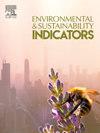结合行星边界- lca和甜甜圈来评估系统的社会影响
IF 5.4
Q1 ENVIRONMENTAL SCIENCES
引用次数: 0
摘要
生命周期评价是目前应用最广泛的生态影响评价方法。这种方法只考虑了可持续性的生态部分,尽管社会问题变得越来越重要。“社会生命周期评估”(S-LCA)的发展填补了这一空白,但在实践中很少使用。事实上,它是复杂的,并且缺乏实施S-LCA的明确指导方针,特别是在本地化(适应上下文)指标方面,这通常意味着各种利益相关者的参与。我们的假设是,社会指标可以通过数学相关性与生态指标联系起来。因此,它允许使用这些相关性来评估社会影响。本文提供了一种方法来做到这一点,将行星边界LCA (PB-LCA)作为输入,并通过缩小该PB-LCA实现本地化。我们的建议是通过一个案例来说明的。插图强调了如何将社会和生态维度联系和解释,但也有一些弱点,例如它依赖于PB-LCA,这是一种尚未广泛传播的方法,从而导致从业者在实际条件下使用的局限性。为了补救这一点,我们对希望使用这种方法的从业者提出初步建议。此外,从业者必须谨慎地解释结果:它们只是一个统计表示。从业者应该用实地方法(面试等)来验证这个数学方法。本文章由计算机程序翻译,如有差异,请以英文原文为准。
A combination of Planetary Boundaries-LCA and the Doughnut to assess social impacts of systems
Life Cycle Assessment is the most widely used method for assessing ecological impacts. This method only considers the ecological part of the sustainability, although social issues are becoming increasingly important. “Social life cycle assessment” (S-LCA) has been developed to fill this gap, but it is rarely used in practice. In fact, it is complex and there is a lack of clear guidelines to implement S-LCA, especially for localising (adapting to a context), the indicators, which often imply the involvement of various stakeholders.
Our hypothesis is that social indicators can be linked to ecological indicators through a mathematical correlation. Thus it allows the assessment of social impacts using these correlations. This article provide a method to do so, taking as input a Planetary-Boundaries LCA (PB-LCA) and achieving localisation by a downscaling of this PB-LCA. Our proposal is illustrated by a case study. The illustration highlights how to link and interpret the social and ecological dimensions, but also some weaknesses, such as the fact that it depends on PB-LCA, a method not yet widely spread, thus causing limitations of use by practitioners under real conditions. To remedy this, we make preliminary recommendations for practitioners wishing to use this method. Furthermore, the results must be interpreted with caution by practitioners: they are only a statistical representation. Practitioners should validate this mathematical approach with a field approach (interviews, etc.).
求助全文
通过发布文献求助,成功后即可免费获取论文全文。
去求助
来源期刊

Environmental and Sustainability Indicators
Environmental Science-Environmental Science (miscellaneous)
CiteScore
7.80
自引率
2.30%
发文量
49
审稿时长
57 days
 求助内容:
求助内容: 应助结果提醒方式:
应助结果提醒方式:


